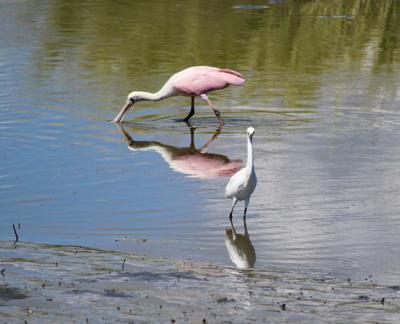This article was first seen in the Post and Courier.
The Christmas ornaments are packed away and the Hoppin’ John and collard greens have been consumed. The weather is unpredictable and deer season is over. It’s January, so what’s an outdoors lover to do?
Get out and enjoy the bounty of natural beauty we share in South Carolina. I missed the traditional New Year’s Day hike, but did manage to get out with family members and cover several miles on a Second-Day Hike on the West Ashley Greenway, where we observed a couple of wood storks, egrets, a flock of Canada geese and numerous other species of birds.
I’m not a birder, but I do enjoy watching and photographing them. And one of the best spots to watch a variety of birds is just up the road at Huntington Beach State Park, which also happens to be one of the camping sites my wife and I frequent.
Bird enthusiasts armed with every variety of cameras and spotting scopes patrol the causeway leading into the park. We’ve spotted roseate spoonbills, white pelicans, brown pelicans, ospreys, wood storks, blue herons, a plethora of shorebirds and even watched a bald eagle flying in the distance. And every visit I’m reminded that I probably should be carrying a field guide to help me better identify the birds.

Birds aren’t the only wildlife you may encounter on your walk in the woods or along the waterways of our state. Alligators sunning. Skittish deer. Raccoons.
January is one of those months that my wife and I try to get out and do some exploring. We’ll often check out different state parks to see if they might be a potential camping destination.
Some resources we’ve used to find interesting places include the following websites: South Carolina State Parks (southcarolinaparks.com); Charleston County Parks and Recreation (ccprc.com); and Only in Your State (onlyinyourstate.com).
The following spots are just a sampling of great locations to visit within a short drive from Charleston. Check for hours of operation and entrance fees before heading out. Now get out and enjoy.
- Beidler Forest (Harleyville) — The world’s largest virgin cypress-tupelo swamp forest preserved by Audubon South Carolina and located in Four Holes Swamp has thousand-year-old trees and a wide variety of wildlife. Enjoy from a 1.75-mile boardwalk.
- Botany Bay Plantation Heritage Preserve (Edisto Island) — This 3,363-acre preserve is operated by S.C. Department of Natural Resources and features a boneyard beach and a scenic driving tour. Collecting shells is not allowed on the beach.
- Caw Caw Interpretive Center (Ravenel) — Was once part of several rice plantations, includes more than six miles of trails, including elevated boardwalks through wetlands. There’s a good chance to spot alligators and more than 250 species of birds have been spotted here.
- Congaree National Park (Hopkins) — More than 26,000 acres of preserved old-growth bottomland hardwood forest, it features numerous hiking trails for all levels of hikers. It’s just under a two-hour drive from Charleston.
- Cypress Gardens (Goose Creek) — Operated by the City of Charleston and recently reopened after a four-year closure due to historic flooding, this 170-acre preserve offers 3½ miles of walking and hiking trails, swamp boat tours, a butterfly house, and the “Swamparium.”
- Edisto Beach State Park (Edisto Beach) — This park is in two sections, with 1½ miles of beachfront and the Live Oak Campground. Edisto Beach State Park has numerous hiking trails, including the state’s longest wheelchair accessible trails.
- Huntington Beach State Park (Murrells Inlet) — Three miles of pristine beach and 2,500 acres in size, Huntington Beach is a birder’s paradise that also offers several nice walking and hiking trails. You also can visit Atalaya, the Moorish-style home that was the winter retreat of 20th-century sculptor Anna Hyatt Huntington and her husband Archer.
- Laurel Hill County Park (Mount Pleasant) — This 745-acre park features several miles of running, walking or biking trails.
- Meggett County Park (Meggett) — Features five miles of trails within a 416-acre park that is adjacent to tributaries of the Toogoodoo River.
- Palmetto Trail (statewide) — This trail begins in Awendaw at Buck Hall Recreation Area and meanders across South Carolina to Oconee County, but it’s easily broken down into interesting day hikes. Visit palmettoconservation.org to download maps.
- Old Santee Canal (Moncks Corner) — This 195-acre park features four miles of boardwalk and was part of the original 22-mile canal that helped connect the Santee and Cooper rivers. There’s also an interpretive center.
- Santee State Park (Santee) — A 2,500-acre park located on the shores of Lake Marion, Santee State Park features camping, boating and more than 10 miles of hiking and biking trails.
- West Ashley Greenway (Charleston) — This trail covers 10½ miles along an old railroad bed from South Windermere Shopping Center on Folly Road to Johns Island and is perfect for walking and biking. Running parallel to U.S. Highway 17, it opens up to marshland toward the Johns Island end of the trail.





